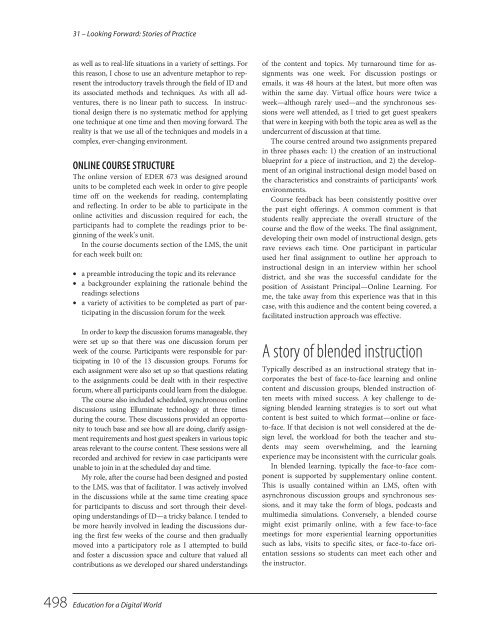Education for a Digital World Advice, Guidelines and Effective Practice from Around Globe, 2008a
Education for a Digital World Advice, Guidelines and Effective Practice from Around Globe, 2008a
Education for a Digital World Advice, Guidelines and Effective Practice from Around Globe, 2008a
You also want an ePaper? Increase the reach of your titles
YUMPU automatically turns print PDFs into web optimized ePapers that Google loves.
31 – Looking Forward: Stories of <strong>Practice</strong><br />
as well as to real-life situations in a variety of settings. For<br />
this reason, I chose to use an adventure metaphor to represent<br />
the introductory travels through the field of ID <strong>and</strong><br />
its associated methods <strong>and</strong> techniques. As with all adventures,<br />
there is no linear path to success. In instructional<br />
design there is no systematic method <strong>for</strong> applying<br />
one technique at one time <strong>and</strong> then moving <strong>for</strong>ward. The<br />
reality is that we use all of the techniques <strong>and</strong> models in a<br />
complex, ever-changing environment.<br />
ONLINE COURSE STRUCTURE<br />
The online version of EDER 673 was designed around<br />
units to be completed each week in order to give people<br />
time off on the weekends <strong>for</strong> reading, contemplating<br />
<strong>and</strong> reflecting. In order to be able to participate in the<br />
online activities <strong>and</strong> discussion required <strong>for</strong> each, the<br />
participants had to complete the readings prior to beginning<br />
of the week’s unit.<br />
In the course documents section of the LMS, the unit<br />
<strong>for</strong> each week built on:<br />
• a preamble introducing the topic <strong>and</strong> its relevance<br />
• a backgrounder explaining the rationale behind the<br />
readings selections<br />
• a variety of activities to be completed as part of participating<br />
in the discussion <strong>for</strong>um <strong>for</strong> the week<br />
In order to keep the discussion <strong>for</strong>ums manageable, they<br />
were set up so that there was one discussion <strong>for</strong>um per<br />
week of the course. Participants were responsible <strong>for</strong> participating<br />
in 10 of the 13 discussion groups. Forums <strong>for</strong><br />
each assignment were also set up so that questions relating<br />
to the assignments could be dealt with in their respective<br />
<strong>for</strong>um, where all participants could learn <strong>from</strong> the dialogue.<br />
The course also included scheduled, synchronous online<br />
discussions using Elluminate technology at three times<br />
during the course. These discussions provided an opportunity<br />
to touch base <strong>and</strong> see how all are doing, clarify assignment<br />
requirements <strong>and</strong> host guest speakers in various topic<br />
areas relevant to the course content. These sessions were all<br />
recorded <strong>and</strong> archived <strong>for</strong> review in case participants were<br />
unable to join in at the scheduled day <strong>and</strong> time.<br />
My role, after the course had been designed <strong>and</strong> posted<br />
to the LMS, was that of facilitator. I was actively involved<br />
in the discussions while at the same time creating space<br />
<strong>for</strong> participants to discuss <strong>and</strong> sort through their developing<br />
underst<strong>and</strong>ings of ID—a tricky balance. I tended to<br />
be more heavily involved in leading the discussions during<br />
the first few weeks of the course <strong>and</strong> then gradually<br />
moved into a participatory role as I attempted to build<br />
<strong>and</strong> foster a discussion space <strong>and</strong> culture that valued all<br />
contributions as we developed our shared underst<strong>and</strong>ings<br />
of the content <strong>and</strong> topics. My turnaround time <strong>for</strong> assignments<br />
was one week. For discussion postings or<br />
emails, it was 48 hours at the latest, but more often was<br />
within the same day. Virtual office hours were twice a<br />
week—although rarely used—<strong>and</strong> the synchronous sessions<br />
were well attended, as I tried to get guest speakers<br />
that were in keeping with both the topic area as well as the<br />
undercurrent of discussion at that time.<br />
The course centred around two assignments prepared<br />
in three phases each: 1) the creation of an instructional<br />
blueprint <strong>for</strong> a piece of instruction, <strong>and</strong> 2) the development<br />
of an original instructional design model based on<br />
the characteristics <strong>and</strong> constraints of participants’ work<br />
environments.<br />
Course feedback has been consistently positive over<br />
the past eight offerings. A common comment is that<br />
students really appreciate the overall structure of the<br />
course <strong>and</strong> the flow of the weeks. The final assignment,<br />
developing their own model of instructional design, gets<br />
rave reviews each time. One participant in particular<br />
used her final assignment to outline her approach to<br />
instructional design in an interview within her school<br />
district, <strong>and</strong> she was the successful c<strong>and</strong>idate <strong>for</strong> the<br />
position of Assistant Principal—Online Learning. For<br />
me, the take away <strong>from</strong> this experience was that in this<br />
case, with this audience <strong>and</strong> the content being covered, a<br />
facilitated instruction approach was effective.<br />
A story of blended instruction<br />
Typically described as an instructional strategy that incorporates<br />
the best of face-to-face learning <strong>and</strong> online<br />
content <strong>and</strong> discussion groups, blended instruction often<br />
meets with mixed success. A key challenge to designing<br />
blended learning strategies is to sort out what<br />
content is best suited to which <strong>for</strong>mat—online or faceto-face.<br />
If that decision is not well considered at the design<br />
level, the workload <strong>for</strong> both the teacher <strong>and</strong> students<br />
may seem overwhelming, <strong>and</strong> the learning<br />
experience may be inconsistent with the curricular goals.<br />
In blended learning, typically the face-to-face component<br />
is supported by supplementary online content.<br />
This is usually contained within an LMS, often with<br />
asynchronous discussion groups <strong>and</strong> synchronous sessions,<br />
<strong>and</strong> it may take the <strong>for</strong>m of blogs, podcasts <strong>and</strong><br />
multimedia simulations. Conversely, a blended course<br />
might exist primarily online, with a few face-to-face<br />
meetings <strong>for</strong> more experiential learning opportunities<br />
such as labs, visits to specific sites, or face-to-face orientation<br />
sessions so students can meet each other <strong>and</strong><br />
the instructor.<br />
498 <strong>Education</strong> <strong>for</strong> a <strong>Digital</strong> <strong>World</strong>


















